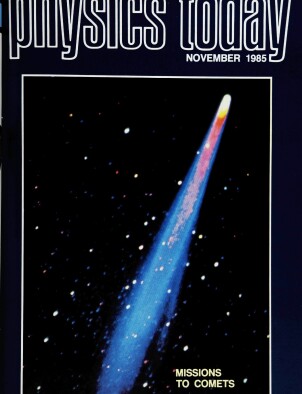Comparitive Magnetospheres
DOI: 10.1063/1.880990
A major discovery to emerge from the era of spacecraft investigations of the solar system is the high degree to which planetary magnetic fields organize ionized matter. The spectacular images of planetary surfaces, atmospheres and satellites beamed to Earth by unmanned spacecraft have attracted much attention. However, the discovery of unexpected large‐scale plasma formations within the magnetospheres of the planets is equally important because the behavior of these plasmas gives us insight into the way plasmas behave on cosmological scales.
This article is only available in PDF format
References
1. See H. Alfvén, Cosmic Plasma, Reidel, Dordrecht, Holland (1981).
2. S.‐I. Akasofu, L. J. Lanzerotti, PHYSICS TODAY December 1975, p. 28;
L. J. Lanzerotti, Astron. and Aeron. April 1981, p. 57 ;
S.‐I. Akasofu, S. Chapman, Solar‐Terrestrial Physics, Oxford, London (1972).3. G. L. Siscoe, in Solar System Plasma Physics, C. F. Kennel, L. J. Lanzerotti, E. N. Parker, eds., North Holland, Amsterdam (1979), vol. 2, p. 319.
4. H. Alfvén, Tellus 6, 232 (1954).https://doi.org/TELLAL
5. R. M. Kulsrud, in Particle Acceleration Mechanisms in Astrophysics, J. Arons, C. Max, C. McKee, eds., AIP Conf. Proc. no. 56, AIP, New York (1979), p. 13.
6. N. F. Ness, Ann. Rev. Earth Planet. Sci. 7, 249 (1979).https://doi.org/AREPCI
7. C. T. Russell, in Solar System Plasma Physics, C. F. Kennel, L. J. Lanzerotti, E. N. Parker, eds., North Holland, Amsterdam (1979), vol. 2, p. 207.
8. J. Geophys. Res. 79, 3487 (1974) (Pioneer Jupiter issue); https://doi.org/JGREA2
J. Geophys. Res. 86, 8123 (1981) (Voyager Jupiter issue).https://doi.org/JGREA29. S. M. Krimigis, J. S. Carbary, E. P. Keath, C. O. Bostrom, W. I. Axford, G. Gloeckler, L. J. Lanzerotti, T. P. Armstrong, J. Geophys. Res. 86, 8227 (1981).https://doi.org/JGREA2
10. T. W. Hill, A. J. Dessler, C. K. Goertz, in Physics of the Jovian Magnetosphere, A. J. Dessler, ed., Cambridge U.P. (1983), p. 353.
11. R. L. McNuttJr, Adv. Space Res. 3, 55 (1983).https://doi.org/ASRSDW
12. F. Bagenal, J. D. Sullivan, J. Geophys. Res. 86, 8447 (1981); https://doi.org/JGREA2
D. L. Matson, B. A. Goldberg, T. V. Johnson, R. W. Carlson, Science 199, 531 (1978); https://doi.org/SCIEAS
J. T. Trauger, Science 226, 337 (1984).https://doi.org/SCIEAS13. N. F. Ness, M. H. Acuña, R. P. Lepping, L. F. Burlaga, K. W. Behannon, F. M. Neubauer, Science 204, 982 (1979).https://doi.org/SCIEAS
14. K. R. Pyle, J. A. Simpson, Astrophys. J. 215, L89 (1977).https://doi.org/ASJOAB
15. R. D. Zwickl, S. M. Krimigis, J. F. Carbary, E. P. Keath, T. P. Armstrong, D. C. Hamilton, G. Gloeckler, J. Geophys. Res. 86, 8125 (1981).https://doi.org/JGREA2
16. D. C. Hamilton, G. Gloeckler, S. M. Krimigis, L. J. Lanzerotti, J. Geophys. Res. 86, 8301 (1981).https://doi.org/JGREA2
17. C. K. Goertz, J. Geophys. Res. 83, 3145 (1978).https://doi.org/JGREA2
18. A. F. Cheng, Astrophys. J. 242, 812 (1980).https://doi.org/ASJOAB
19. J. Geophys. Res. 85, 5651 (1980) (Pioneer Saturn issue); https://doi.org/JGREA2
J. Geophys. Res. 88, 8625 (1983) (Voyager Saturn issue).https://doi.org/JGREA220. S. M. Krimigis, J. F. Carbary, E. P. Keath, T. P. Armstrong, L. J. Lanzerotti, G. Gloecker, J. Geophys. Res. 88, 8871 (1983).https://doi.org/JGREA2
21. S. T. Durrance, H. A. Moos, Nature 299, 428 (1982); https://doi.org/NATUAS
J. T. Clarke, Astrophys. J. 263, L105 (1982).https://doi.org/ASJOAB22. J. Geophys. Res. 87, 1351 (1982) (Voyager Titan issue).https://doi.org/JGREA2
23. S. M. Krimigis, Proc. 17th Intl. Cosmic Ray Conf. 12, 229 (1981).
24. M. H. Acuña, J. K. Alexander, R. A. Brown, T. W. Hill, S. M. Krimigis, L. J. Lanzerotti, G. L. Siscoe, Space Sci. Rev. 35, 269 (1983).https://doi.org/SPSRA4
More about the Authors
Louis J. Lanzerotti. AT&T Bell Laboratories, Murray Hill, New Jersey.
Stamatios M. Krimigis. Johns Hopkins University Applied Physics Laboratory, Laurel, Maryland.




